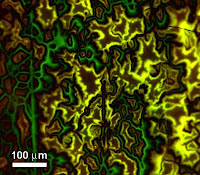Strain has major effect on high-temp superconductors
The measurements, reported in Applied Physics Letters,* revealed a 40 percent reduction in critical current, the point at which superconductivity breaks down, at just 1 percent compressive strain. This effect can be readily accommodated in the engineering design of practical applications, NIST project leader Jack Ekin says, but knowing about it ahead of time will be important to the success of many large-scale devices. The effect was measured in three types of yttrium-barium-copper-oxide (YBCO), a brittle ceramic considered the best prospect for making low-cost, high-current, superconducting wires. The researchers developed a “four point" bend technique that enables studies of superconducting properties over a wide range of uniform strain at high current levels. The superconductor is soldered on top of a flexible metal beam, which is then bent up or down at both ends while the critical current is measured.
| The discovery is the first major reversible strain effect found in practical high-temperature superconductors, which generally have been tested under smaller tensile strains only, or at strains so high they caused the material to break down permanently. The newly discovered effect is totally reversible and symmetric for both compressive and tensile (pushing and pulling) strains, suggesting it is intrinsic to the fundamental mechanism of superconductivity in YBCO. |
* D.C. van der Laan and J.W. Ekin. Large intrinsic effect of axial strain on the critical current of high-temperature superconductors for electric power applications. Applied Physics Letters, 90, 052506, 2006. Posted online Jan. 31.
Contact: Laura Ost laura.ost@nist.gov 303-497-4880 National Institute of Standards and Technology (NIST)
Technorati Tags: High-Temp Superconductors and magnetic fields or National Institute of Standards and Technology and NIST, or superconductivity and U.S. Department of Energy or axial strain and Physics











No comments:
Post a Comment